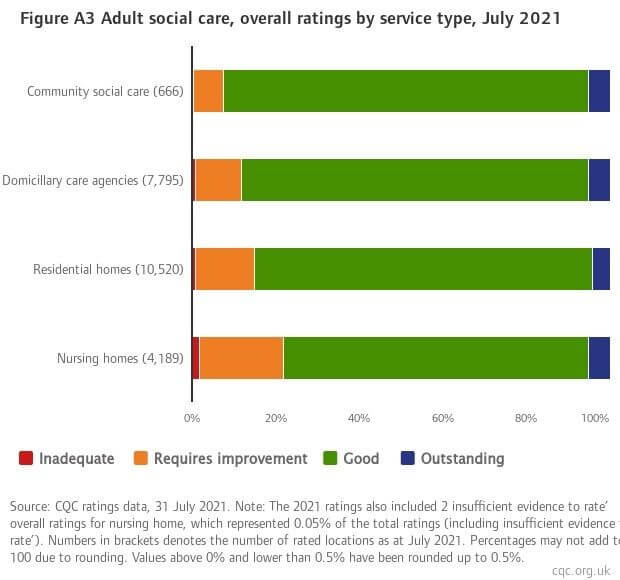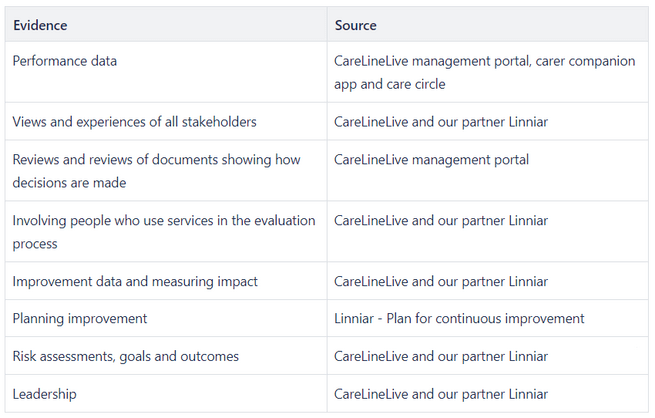Self-evaluation is increasingly becoming a part of regulatory organisations’ requirements. It is no longer sufficient to simply check off boxes to meet regulatory milestones; providers are now responsible for evaluating their services with the goal of learning, development and improving their service.
Self-evaluation is a valuable tool that empowers businesses to take informed decisions which will undoubtedly contribute to a safe and successful service. Health and care services have a raft of key responsibilities that include compliance relating to industry standards, regulations and legislation.
Self-evaluation is essential not only for business operations and growth but in the context of a health or social care service it’s vital for identifying strengths, weaknesses and areas of improvement in order to keep people safe, whilst promoting health, well-being and independence. It can go a long way to identifying areas of concern and therefore giving providers the opportunity to make changes necessary to be outstanding in the delivery of care and support.
It is important to recognise that many home care services are achieving best practice and responding to learning, development, and improvement insights. Conversely, there are a significant number of adult social care services that are not meeting the required standards and are still in need of varying degrees of improvement (See CQC statistics below).

Measuring performance, skills and capabilities
Self-evaluation is used to measure performance, skills and capabilities the results of which are used to drive improvement. Alignment with the goals and values of the organisation, together with industry guidance will facilitate the development of evaluation tools. A major part of the process is the involvement of all stakeholders who should be empowered to work collaboratively with leaders to set objectives and goals in planning specific areas identified for continual improvement. Feedback is a key aspect of self-evaluation and is necessary to give service leaders real insights into the experiences that people face when accessing, working or collaborating with services.
Key aspects of self evaluation
Businesses can become chaotic and unsafe very quickly if self-evaluation is not streamlined and embedded into a service. Setting clear objectives is essential, and sharing these will support those working within the service to be aligned with expectations, goals and what outcomes should look like. The data collected will give clear information of what is desired and being accomplished and will most definitely identify areas of weakness, concern and areas for improvement. The monitoring of progress and measuring the impact of continuous learning and improvement through self-evaluation will inevitably lead to positive outcomes for services.
Let’s have a look at how self-evaluation will help home care services to meet high quality service delivery and regulatory compliance.
Set clear objectives
Regardless of which regulatory organisation, local authority or integrated care board you fall under, self-evaluation and continual assessment of the service is a must. Every person working within a service will be keen to know how it is performing and people using and accessing services will most definitely want to know that services are safe, caring, responsive, effective and well-led. They will want to be sure that referrals and transitions between services are managed proactively and successfully, with personal data being available in real time to whichever service requires it.
Key areas for home care services to focus on are encompassed by competent and effective leadership. This will include the evaluation of how well people are supported to live healthy, fulfilled and independent lives that keep them safe and free from harm and abuse. There are also areas that leaders will expand on through data analysis, including how well care is planned and delivered, how well staff are recruited, trained, supported and retained and well-led is the service from top down.
Monitoring progress for continuous learning
There must be rigorous monitoring and systematic processes in place that produce data showing evidence of continuous assessment which can be used for analysis and in turn can be used for service improvement. Self-evaluation is ongoing, it’s not something that is done once per year and forgotten about, therefore processes and improvement plans should be developed, reviewed and adjusted as necessary. Learnings should give opportunities for reflective practice involving all stakeholders leading to collective planning and effective responses to problem solving.
Self-evaluation – key areas to focus on
The focus is to ensure that all stakeholders have a positive experience when interacting with services and that care support and treatment is of the highest of standard. Evaluation methods will include quantitative data collection, direct observation of practice and evidence of processes and related documentation giving detail of people’s views and experiences. It’s important to gain a holistic view of the services and therefore feedback must be collected from all stakeholders.
For providers of home care the focus is on the experiences of:
- People using the service
- Relatives, advocates and representatives
- Related healthcare and community professionals and services
- Commissioners and local authority representatives
Areas of self evaluation vary dependent on the service type, location and client needs, however there are internal and external areas which should be considered for evaluation for example:
- How well are people being supported?
- How are the needs of the local community being identified and reflected in service development?
- How well is care planned and does care planning support the unique needs of each individual person?
- How is this being monitored, reviewed and where necessary how is planning for improvement actioned and implemented?
- How good is the staff team?
- Are staff well recruited to meet the needs of the people using the service?
- Are staff empowered to have a voice within the service?
- How are staff supported to be a cohesive team? How are lone workers supported and kept safe?
- Are staff confident that they are being well led?
- Is staff competency, training and upskilling meeting the needs of the service and meeting staff expectation for professional development?
- Do staff understand their roles and responsibilities?
- How good is the management and leadership of the service?
- What are the vision, values, goals and outcomes planned for the service?
- How are opportunities of continuous identified and actioned?
- How are areas of improvement prioritised?
- What is the process for service improvement planning, testing and implementation
- How are these being actioned and how is data collected to give insights into achievements and areas of concern and improvement?
- How is quality monitored and improvement plans implemented?
- How are changes in the service planned for and adopted by members of staff
- How is communication between services monitored and actioned when issues are identified?
- What processes are in place for business continuity?
How CareLineLive and our software partner Linniar supports self-evaluation

Self-evaluation of every aspect of a service will improve the health, emotional and social well-being of people using services and makes for a more involved, informed and happier workforce. It’s a value that cannot be underestimated and will empower staff across the board to take control of their areas of responsibility, aiding informed decision making and driving successful service improvement.



